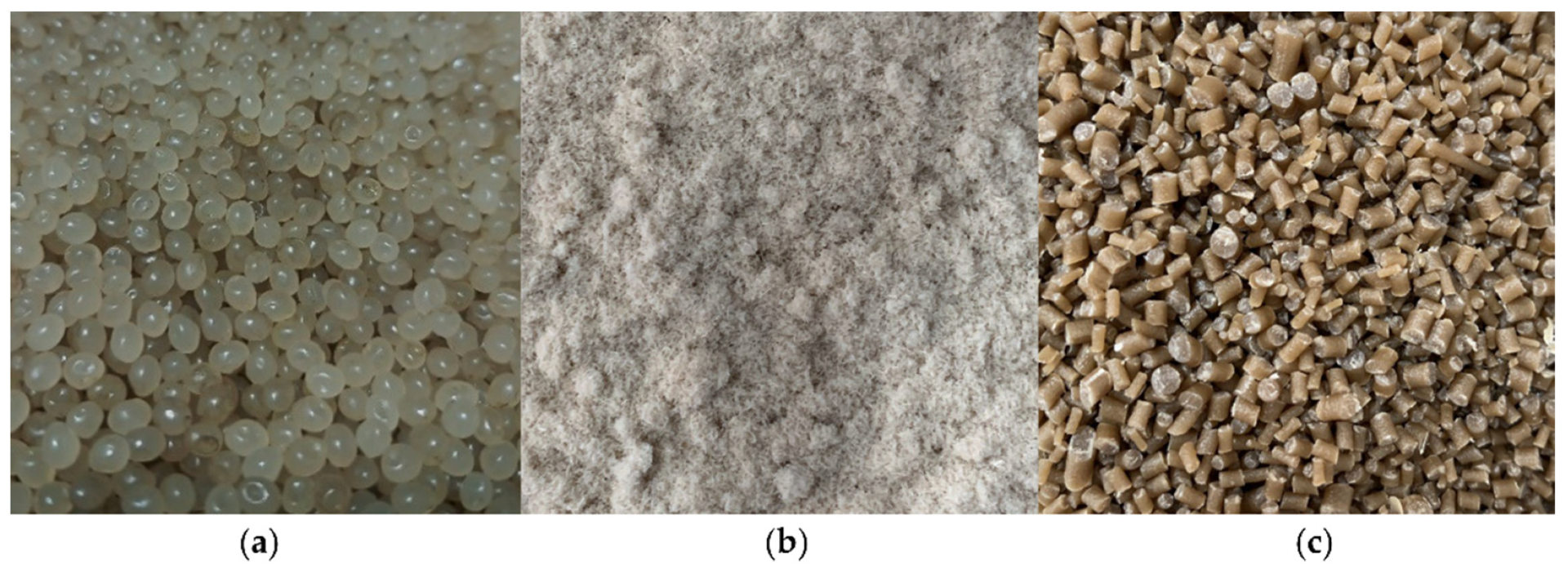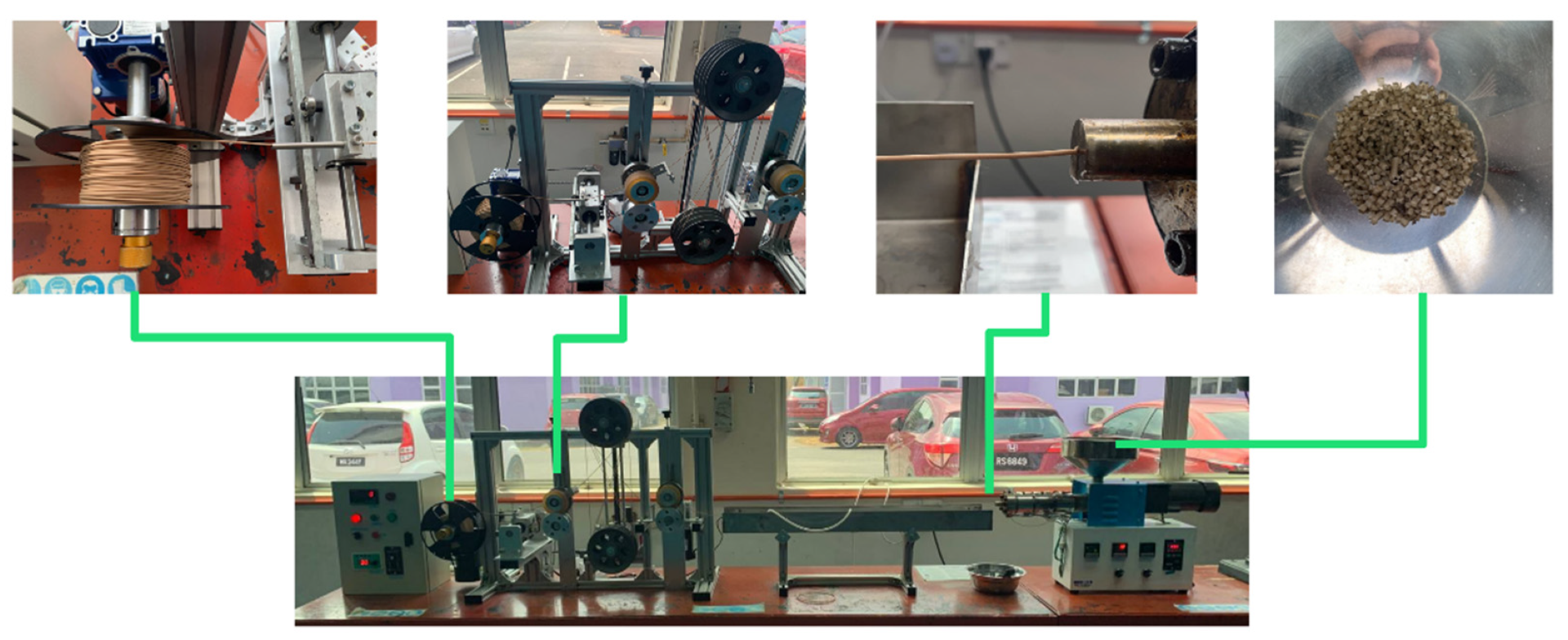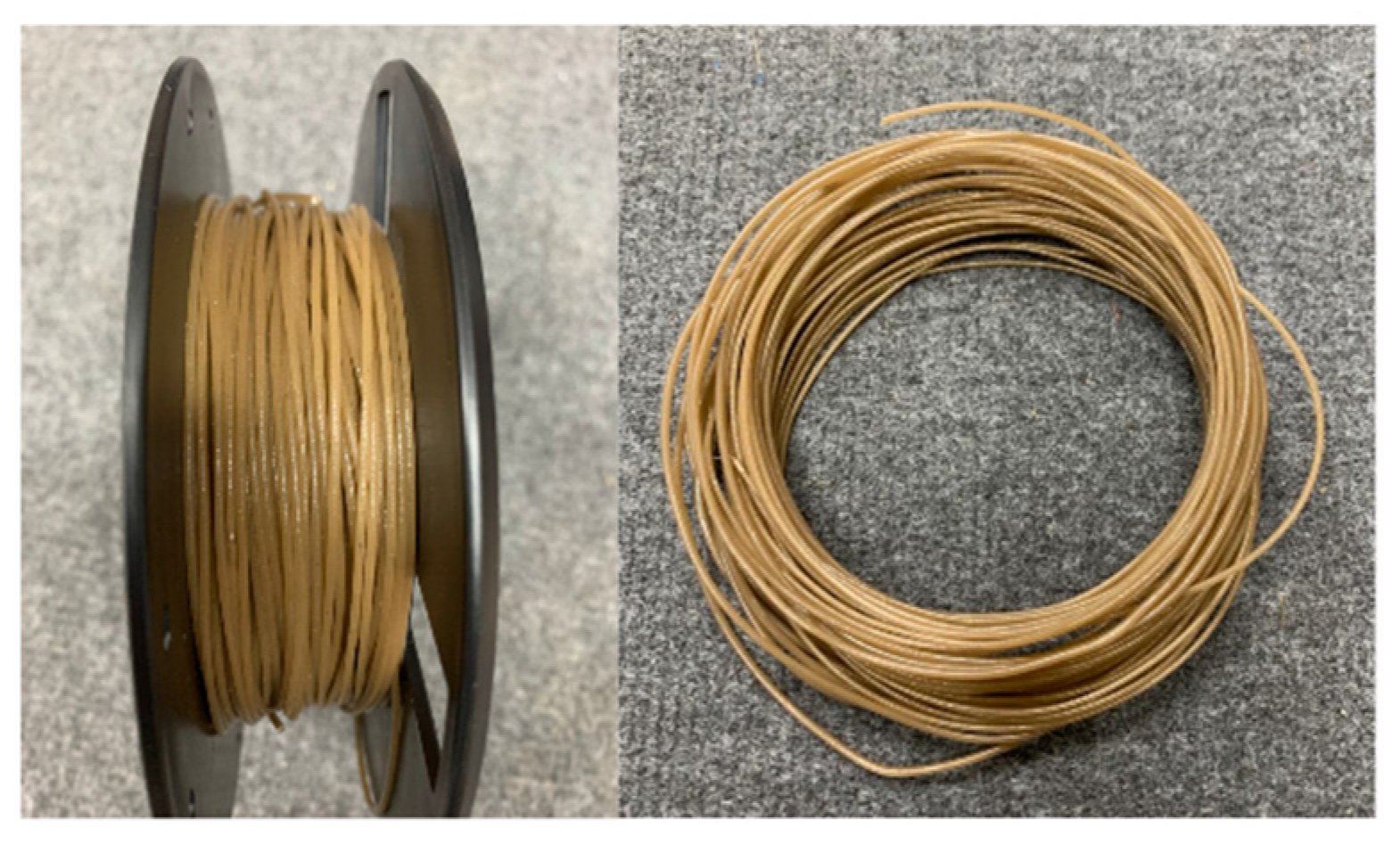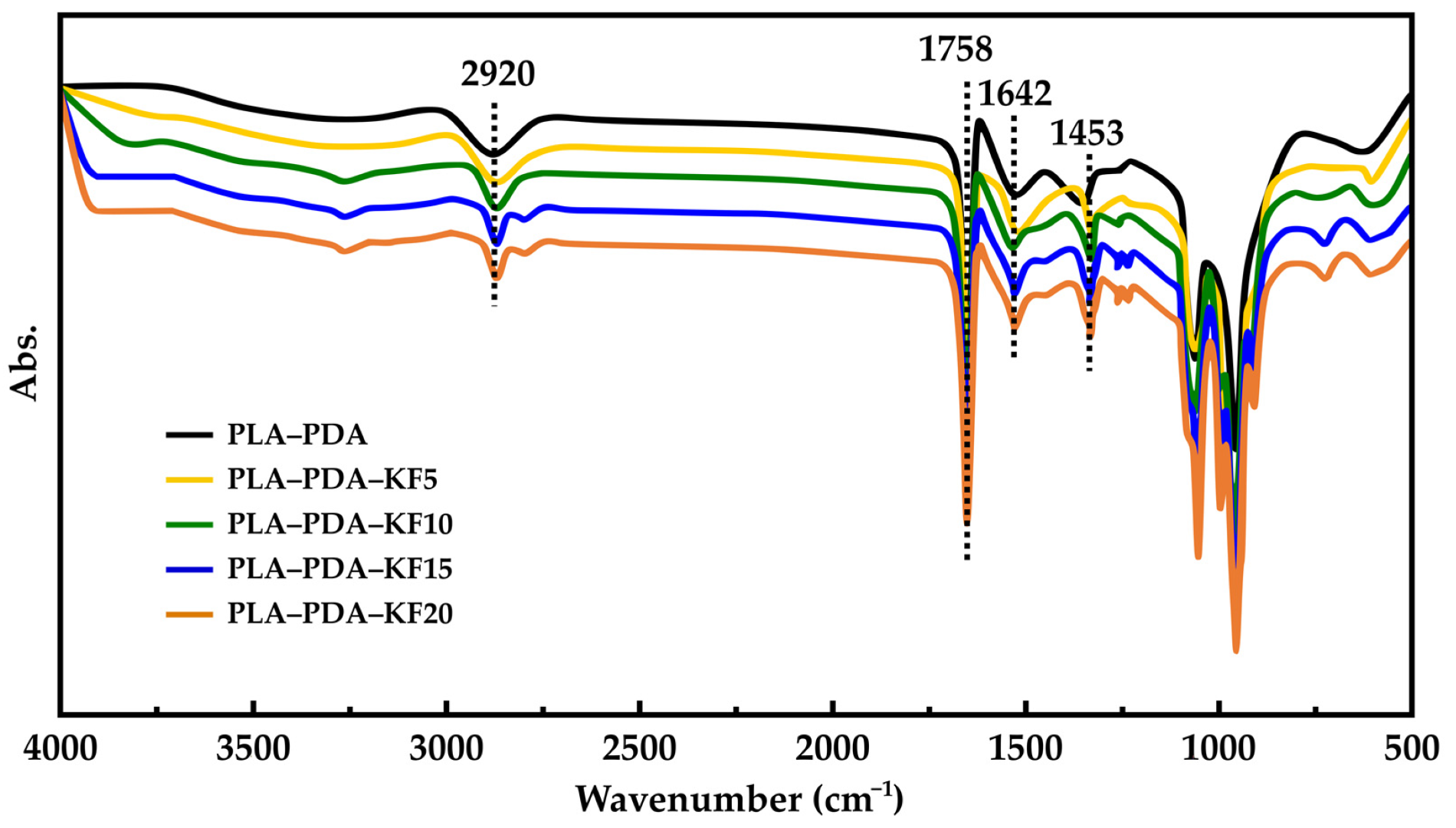The Effects of Self-Polymerized Polydopamine Coating on Mechanical Properties of Polylactic Acid (PLA)–Kenaf Fiber (KF) in Fused Deposition Modeling (FDM)
Abstract
:1. Introduction
2. Materials and Methods
2.1. Materials
2.2. Preparation of PLA-Coated Dopamine and Granule Kenaf Fiber
2.3. Preparation of PLA–PDA Pellets Blended with Granule Kenaf Fiber (PLA–PDA–Kenaf Pellet)
2.4. Preparation of PLA–PDA–Kenaf Filament
2.5. Fabrication of PLA–PDA–Kenaf FDM Specimens
2.6. Characterization
2.6.1. FTIR on PLA–PDA-Coated Pellets
2.6.2. Mechanical Characterization of PLA–PDA–Kenaf FDM-Printed Specimens
2.6.3. Microstructure Morphology Analysis (SEM)
3. Results and Discussions
3.1. FTIR Analyses of PDA–PLA Coated Pellets
3.2. The Effects of PDA Coating and Kenaf Fiber on Mechanical Properties of PLA–Kenaf Composite FDM-Printed Specimens
3.3. The Effects of PDA Coating and Kenaf Fiber on Fracture Surfaces of PLA–Kenaf Composite FDM-Printed Specimens
4. Conclusions
- ▪ By adding dopamine to the filament composites (PLA–PDA–KF), it acted as a coupling agent that created chemical bonds between kenaf fibers and the PLA matrix. This led to an improvement in the interfacial adhesion of PLA and KF, leading to improved tensile, compression, and flexural properties.
- ▪ As the content of bast kenaf fiber increased, there was a proportional increase in the density and porosity of the PLA–PDA–KF FDM specimens.
- ▪ The increase in the Young’s modulus observed in PLA–PDA–KF5 can be attributed to the stable condition of optimum homogeneity in the blended composite, which can enhance bonding between kenaf fiber particles and the PLA matrix, along with the decrease in clustering and empty spaces compared to the initial printed PLA.
- ▪ The tensile, compressive, and flexural stresses and strains at break of blended FDM filament composites with up to 5% kenaf fiber content surpassed those of the virgin printed PLA as a result of the reinforcement provided by kenaf fibers, which delayed crack growth. However, for contents of 5% and higher, the tensile, compressive, and flexural stresses of the FDM-printed specimen were lower than the virgin printed PLA.
- ▪ Upon conducting a tensile test on the FDM specimen of the PLA–PDA–KF composite, it was observed through microscopic characterization that an escalation in voids and defects occurred as the kenaf content increased. This phenomenon was attributed to the agglomeration of particles within the material.
- ▪ Based on the results, FDM-printed composites made from PLA-coated PDA with kenaf fiber reinforcement possess remarkable mechanical properties, indicating their potential to be utilized as sustainable materials. The addition of dopamine as an adhesion agent during pellet coating further strengthens the printed FDM composite compared to regular PLA–KF blending, increasing the interfacial strength between the kenaf fiber surface and PLA matrix.
Author Contributions
Funding
Institutional Review Board Statement
Data Availability Statement
Acknowledgments
Conflicts of Interest
References
- Park, S.; Shou, W.; Makatura, L.; Matusik, W.; Fu, K. 3D printing of polymer composites: Materials, processes, and applications. Matter 2022, 5, 43–76. [Google Scholar] [CrossRef]
- Karakurt, I.; Lin, L. 3D printing technologies: Techniques, materials, and post-processing. Curr. Opin. Chem. Eng. 2020, 28, 134–143. [Google Scholar] [CrossRef]
- Brischetto, S.; Torre, R. Tensile and Compressive Behavior in the Experimental Tests for PLA Specimens Produced via Fused Deposition Modelling Technique. J. Compos. Sci. 2020, 4, 140. [Google Scholar] [CrossRef]
- Awasthi, P.; Banerjee, S.S. Fused deposition modeling of thermoplastic elastomeric materials: Challenges and opportunities. Addit. Manuf. 2021, 46, 102177. [Google Scholar] [CrossRef]
- Mustapha, K.; Metwalli, K.M. A review of fused deposition modelling for 3D printing of smart polymeric materials and composites. Eur. Polym. J. 2021, 156, 110591. [Google Scholar] [CrossRef]
- Djukić-Vuković, A.; Mladenović, D.; Ivanovic, J.; Pejin, J.; Mojović, L. Towards sustainability of lactic acid and poly-lactic acid polymers production. Renew. Sustain. Energy Rev. 2019, 108, 238–252. [Google Scholar] [CrossRef]
- Muthe, L.P.; Pickering, K.; Gauss, C. A Review of 3D/4D Printing of Poly-Lactic Acid Composites with Bio-Derived Reinforcements. Compos. Part C Open Access 2022, 8, 100271. [Google Scholar] [CrossRef]
- Chen, Y.; Lu, T.; Li, L.; Zhang, H.; Wang, H.; Ke, F. Fully biodegradable PLA composite with improved mechanical properties via 3D printing. Mater. Lett. 2022, 331, 133543. [Google Scholar] [CrossRef]
- Martín, M.J.; Auñón, J.A.; Martín, F. Influence of Infill Pattern on Mechanical Behavior of Polymeric and Composites Specimens Manufactured Using Fused Filament Fabrication Technology. Polymers 2021, 13, 2934. [Google Scholar] [CrossRef]
- Arockiam, A.J.; Subramanian, K.; Padmanabhan, R.; Selvaraj, R.; Bagal, D.K.; Rajesh, S. A review on PLA with different fillers used as a filament in 3D printing. Mater. Today Proc. 2021, 50, 2057–2064. [Google Scholar] [CrossRef]
- Bhagia, S.; Bornani, K.; Agrawal, R.; Satlewal, A.; Ďurkovič, J.; Lagaňa, R.; Bhagia, M.; Yoo, C.G.; Zhao, X.; Kunc, V.; et al. Critical review of FDM 3D printing of PLA biocomposites filled with biomass resources, characterization, biodegradability, upcycling and opportunities for biorefineries. Appl. Mater. Today 2021, 24, 101078. [Google Scholar] [CrossRef]
- Scaffaro, R.; Citarrella, M.C.; Catania, A.; Settanni, L. Green composites based on biodegradable polymers and anchovy (Engraulis encrasicolus) waste suitable for 3D printing applications. Compos. Sci. Technol. 2022, 230, 109768. [Google Scholar] [CrossRef]
- Rajeshkumar, G.; Seshadri, S.A.; Devnani, G.; Sanjay, M.; Siengchin, S.; Maran, J.P.; Al-Dhabi, N.A.; Karuppiah, P.; Mariadhas, V.A.; Sivarajasekar, N.; et al. Environment friendly, renewable and sustainable poly lactic acid (PLA) based natural fiber reinforced composites—A comprehensive review. J. Clean. Prod. 2021, 310, 127483. [Google Scholar] [CrossRef]
- Trivedi, A.K.; Gupta, M.K.; Singh, H. PLA Based Biocomposites for Sustainable Products: A Review. Adv. Ind. Eng. Polym. Res. 2023, 2542–5048, in Press. [Google Scholar] [CrossRef]
- Kamarudin, S.H.; Basri, M.S.M.; Rayung, M.; Abu, F.; Ahmad, S.; Norizan, M.N.; Osman, S.; Sarifuddin, N.; Desa, M.S.Z.M.; Abdullah, U.H.; et al. A Review on Natural Fiber Reinforced Polymer Composites (NFRPC) for Sustainable Industrial Applications. Polymers 2022, 14, 3698. [Google Scholar] [CrossRef] [PubMed]
- Mishra, P.K.; Senthil, P.; Adarsh, S.; Anoop, M. An investigation to study the combined effect of different infill pattern and infill density on the impact strength of 3D printed polylactic acid parts. Compos. Commun. 2021, 24, 100605. [Google Scholar] [CrossRef]
- Nicolau, A.; Pop, M.A.; Coșereanu, C. 3D Printing Application in Wood Furniture Components Assembling. Materials 2022, 15, 2907. [Google Scholar] [CrossRef] [PubMed]
- Shahzad, Q.; Wang, X.; Wang, W.; Wan, Y.; Li, G.; Ren, C.; Mao, Y. Coordinated adjustment and optimization of setting time, flowability, and mechanical strength for construction 3D printing material derived from solid waste. Constr. Build. Mater. 2020, 259, 119854. [Google Scholar] [CrossRef]
- Palaniyappan, S.; Sivakumar, N.K. Development of crab shell particle reinforced polylactic acid filaments for 3D printing application. Mater. Lett. 2023, 341, 134257. [Google Scholar] [CrossRef]
- Farazin, A.; Zhang, C.; Gheisizadeh, A.; Shahbazi, A. 3D bio-printing for use as bone replacement tissues: A review of biomedical application. Biomed. Eng. Adv. 2023, 5, 100075. [Google Scholar] [CrossRef]
- Ruiz, L.E.; Pinho, A.C.; Resende, D.N. 3D Printing as a Disruptive Technology for the Circular Economy of Plastic Components of End-of-Life Vehicles: A Systematic Review. Sustainability 2022, 14, 13256. [Google Scholar] [CrossRef]
- Morales, M.A.; Maranon, A.; Hernandez, C.; Michaud, V.; Porras, A. Colombian Sustainability Perspective on Fused Deposition Modeling Technology: Opportunity to Develop Recycled and Biobased 3D Printing Filaments. Polymers 2023, 15, 528. [Google Scholar] [CrossRef]
- Khalid, M.Y.; Al Rashid, A.; Arif, Z.U.; Ahmed, W.; Arshad, H.; Zaidi, A.A. Natural fiber reinforced composites: Sustainable materials for emerging applications. Results Eng. 2021, 11, 100263. [Google Scholar] [CrossRef]
- Badouard, C.; Traon, F.; Denoual, C.; Mayer-Laigle, C.; Paës, G.; Bourmaud, A. Exploring mechanical properties of fully compostable flax reinforced composite filaments for 3D printing applications. Ind. Crop. Prod. 2019, 135, 246–250. [Google Scholar] [CrossRef]
- Al Rashid, A.; Khalid, M.Y.; Imran, R.; Ali, U.; Koc, M. Utilization of Banana Fiber-Reinforced Hybrid Composites in the Sports Industry. Materials 2020, 13, 3167. [Google Scholar] [CrossRef] [PubMed]
- Ayrilmis, N.; Kariž, M.; Kuzman, M.K. Effect of wood flour content on surface properties of 3D printed materials produced from wood flour/PLA filament. Int. J. Polym. Anal. Charact. 2019, 24, 659–666. [Google Scholar] [CrossRef]
- Ahmad, M.N.; Ishak, M.R.; Taha, M.M.; Mustapha, F.; Leman, Z. Irianto Mechanical, thermal and physical characteristics of oil palm (Elaeis Guineensis) fiber reinforced thermoplastic composites for FDM—Type 3D printer. Polym. Test. 2023, 120, 107972. [Google Scholar] [CrossRef]
- Morales, M.A.; Maranon, A.; Hernandez, C.; Porras, A. Development and Characterization of a 3D Printed Cocoa Bean Shell Filled Recycled Polypropylene for Sustainable Composites. Polymers 2021, 13, 3162. [Google Scholar] [CrossRef]
- Daver, F.; Lee, K.P.M.; Brandt, M.; Shanks, R. Cork–PLA composite filaments for fused deposition modelling. Compos. Sci. Technol. 2018, 168, 230–237. [Google Scholar] [CrossRef]
- Vigneshwaran, S.; Sundarakannan, R.; John, K.; Johnson, R.D.J.; Prasath, K.A.; Ajith, S.; Arumugaprabu, V.; Uthayakumar, M. Recent advancement in the natural fiber polymer composites: A comprehensive review. J. Clean. Prod. 2020, 277, 124109. [Google Scholar] [CrossRef]
- Balla, V.K.; Kate, K.H.; Satyavolu, J.; Singh, P.; Tadimeti, J.G.D. Additive manufacturing of natural fiber reinforced polymer composites: Processing and prospects. Compos. Part B Eng. 2019, 174, 106956. [Google Scholar] [CrossRef]
- Rabbi, M.S.; Islam, T.; Islam, G.M.S. Injection-molded natural fiber-reinforced polymer composites—A review. Int. J. Mech. Mater. Eng. 2021, 16, 15. [Google Scholar] [CrossRef]
- Lee, C.H.; Padzil, F.N.B.M.; Lee, S.H.; Ainun, Z.M.A.; Abdullah, L.C. Potential for Natural Fiber Reinforcement in PLA Polymer Filaments for Fused Deposition Modeling (FDM) Additive Manufacturing: A Review. Polymers 2021, 13, 1407. [Google Scholar] [CrossRef] [PubMed]
- Bi, X.; Huang, R. 3D printing of natural fiber and composites: A state-of-the-art review. Mater. Des. 2022, 222, 111065. [Google Scholar] [CrossRef]
- Kristiawan, R.B.; Imaduddin, F.; Ariawan, D.; Ubaidillah; Arifin, Z. A review on the fused deposition modeling (FDM) 3D printing: Filament processing, materials, and printing parameters. Open Eng. 2021, 11, 639–649. [Google Scholar] [CrossRef]
- Rafiee, M.; Abidnejad, R.; Ranta, A.; Ojha, K.; Karakoç, A.; Paltakari, J. Exploring the possibilities of FDM filaments comprising natural fiber-reinforced biocomposites for additive manufacturing. AIMS Mater. Sci. 2021, 8, 524–537. [Google Scholar] [CrossRef]
- Kain, S.; Ecker, J.V.; Haider, A.; Musso, M.; Petutschnigg, A. Effects of the infill pattern on mechanical properties of fused layer modeling (FLM) 3D printed wood/polylactic acid (PLA) composites. Eur. J. Wood Wood Prod. 2019, 78, 65–74. [Google Scholar] [CrossRef]
- Lau, H.; Hussin, M.; Hamat, S.; Abdul Manan, M.; Ibrahim, M.; Zakaria, H. Effect of kenaf fiber loading on the tensile properties of 3D printing PLA filament. Mater. Today Proc. 2023, 2214–7853. [Google Scholar] [CrossRef]
- Shahar, F.S.; Sultan, M.T.H.; Safri, S.N.A.; Jawaid, M.; Abu Talib, A.R.; Basri, A.A.; Shah, A.U. Fatigue and impact properties of 3D printed PLA reinforced with kenaf particles. J. Mater. Res. Technol. 2022, 16, 461–470. [Google Scholar] [CrossRef]
- Aji, I.S.; Sapuan, S.M.; Zainudin, E.S.; Abdan, K. Kenaf fibres as reinforcement for polymeric composites: A review. Int. J. Mech. Mater. Eng. 2009, 4, 239–248. [Google Scholar]
- Islam, S.; Rahman, M.; Hasan, M. Kenaf Fiber Based Bio-Composites: Processing, Characterization and Potential Applications; Elsevier Ltd.: Amsterdam, The Netherlands, 2019. [Google Scholar]
- Bari, E.; Sistani, A.; Morrell, J.J.; Pizzi, A.; Akbari, M.R.; Ribera, J. Current Strategies for the Production of Sustainable Biopolymer Composites. Polymers 2021, 13, 2878. [Google Scholar] [CrossRef] [PubMed]
- Saccani, A.; Molari, L.; Totaro, G.; Manzi, S. Geopolymers Reinforced with Natural Fibers: A Comparison among Different Sources. Appl. Sci. 2021, 11, 11026. [Google Scholar] [CrossRef]
- Salehudiin, N.M.; Salim, N.; Roslan, R.; Abu Bakar, N.H.; Sarmin, S.N. Improving the properties of kenaf reinforced polypropylene composite by alkaline treatment. Mater. Today Proc. 2023, 75, 156–162. [Google Scholar] [CrossRef]
- Kong, X.; Dai, L.; Wang, Y.; Qiao, D.; Hou, S.; Wang, S. Influence of kenaf stalk on printability and performance of 3D printed industrial tailings based geopolymer. Constr. Build. Mater. 2022, 315, 125787. [Google Scholar] [CrossRef]
- Mastura, M.; Najwa, M.S.; Kudus, S.A.; Jumaidin, R.; Nadlene, R. Development of eco-friendly kenaf fiber reinforced ABS (KRABS) composite filament of fused deposition modeling. Mater. Today Proc. 2022, 70, 363–367. [Google Scholar] [CrossRef]
- Manral, A.; Bajpai, P.K. Effect of Non-Acidic Chemical Treatment of Kenaf Fiber on Physico Mechanical Properties of PLA Based Composites. J. Nat. Fibers 2022, 19, 5709–5727. [Google Scholar] [CrossRef]
- Agaliotis, E.M.; Ake-Concha, B.D.; May-Pat, A.; Morales-Arias, J.P.; Bernal, C.; Valadez-Gonzalez, A.; Herrera-Franco, P.J.; Proust, G.; Koh-Dzul, J.F.; Carrillo, J.G.; et al. Tensile Behavior of 3D Printed Polylactic Acid (PLA) Based Composites Reinforced with Natural Fiber. Polymers 2022, 14, 3976. [Google Scholar] [CrossRef] [PubMed]
- Sgriccia, N.; Hawley, M.; Misra, M. Characterization of natural fiber surfaces and natural fiber composites. Compos. Part A Appl. Sci. Manuf. 2008, 39, 1632–1637. [Google Scholar] [CrossRef]
- Hanim, N.; Syafiq, M.D.; Abdul Hamid, Z.A.; Rusli, A.; Abdullah, M.K.; Shuib, R.K. Fused deposition modelling of flexible kenaf fiber/thermopastic polyurethane composites. Prog. Rubber Plast. Recycl. Technol. 2022, 38, 328–342. [Google Scholar] [CrossRef]
- Aumnate, C.; Soatthiyanon, N.; Makmoon, T.; Potiyaraj, P. Polylactic acid/kenaf cellulose biocomposite filaments for melt extrusion based-3D printing. Cellulose 2021, 28, 8509–8525. [Google Scholar] [CrossRef]
- Han, S.N.M.F.; Taha, M.M.; Mansor, M.R.; Rahman, M.A.A. Investigation of tensile and flexural properties of kenaf fiber-reinforced acrylonitrile butadiene styrene composites fabricated by fused deposition modeling. J. Eng. Appl. Sci. 2022, 69, 52. [Google Scholar] [CrossRef]
- Mansingh, B.B.; Binoj, J.; Manikandan, N.; Sai, N.P.; Siengchin, S.; Rangappa, S.M.; Bharath, K.; Indran, S. Kenaf fibers, their composites and applications. In Plant Fibers, Their Composites, and Applications; Woodhead Publishing: Sawston, UK, 2022; pp. 283–304. [Google Scholar] [CrossRef]
- Jamadi, A.H.; Razali, N.; Petrů, M.; Taha, M.M.; Muhammad, N.; Ilyas, R.A. Effect of Chemically Treated Kenaf Fibre on Mechanical and Thermal Properties of PLA Composites Prepared through Fused Deposition Modeling (FDM). Polymers 2021, 13, 3299. [Google Scholar] [CrossRef] [PubMed]
- Zhao, X.G.; Hwang, K.-J.; Lee, D.; Kim, T.; Kim, N. Enhanced mechanical properties of self-polymerized polydopamine-coated recycled PLA filament used in 3D printing. Appl. Surf. Sci. 2018, 441, 381–387. [Google Scholar] [CrossRef]
- Nishizawa, N.; Kawamura, A.; Kohri, M.; Nakamura, Y.; Fujii, S. Polydopamine Particle as a Particulate Emulsifier. Polymers 2016, 8, 62. [Google Scholar] [CrossRef] [PubMed]
- Shen, Q. Advances in unusual interfacial polymerization techniques. Polymer 2023, 270, 125788. [Google Scholar] [CrossRef]
- Das, P.; Reches, M. Revealing the role of catechol moieties in the interactions between peptides and inorganic surfaces. Nanoscale 2016, 8, 15309–15316. [Google Scholar] [CrossRef] [PubMed]
- Cai, W.; Bullerjahn, J.T.; Lallemang, M.; Kroy, K.; Balzer, B.N.; Hugel, T. Angle-dependent strength of a single chemical bond by stereographic force spectroscopy. Chem. Sci. 2022, 13, 5734–5740. [Google Scholar] [CrossRef]
- Zhang, K.; Chen, Z.; Boukhir, M.; Song, W.; Zhang, S. Bioinspired polydopamine deposition and silane grafting modification of bamboo fiber for improved interface compatibility of poly (lactic acid) composites. Int. J. Biol. Macromol. 2022, 201, 121–132. [Google Scholar] [CrossRef]
- Zhou, J.; Wang, B.; Xu, C.; Xu, Y.; Tan, H.; Zhang, X.; Zhang, Y. Performance of composite materials by wood fiber/polydopamine/silver modified PLA and the antibacterial property. J. Mater. Res. Technol. 2022, 18, 428–438. [Google Scholar] [CrossRef]
- Akhtar, M.N.; Sulong, A.B.; Radzi, M.F.; Ismail, N.; Raza, M.; Muhamad, N.; Khan, M.A. Influence of alkaline treatment and fiber loading on the physical and mechanical properties of kenaf/polypropylene composites for variety of applications. Prog. Nat. Sci. 2016, 26, 657–664. [Google Scholar] [CrossRef]
- Herman, M.J.; Liu, C.; Cady, C.; Watkins, E.B.; Miller, N.A.; Duque, A.L.; Yeager, J.D. Biologically inspired reinforcement using polydopamine of polymer bound composites. Compos. Part B Eng. 2023, 254, 110563. [Google Scholar] [CrossRef]
- Kao, C.-T.; Lin, C.-C.; Chen, Y.-W.; Yeh, C.-H.; Fang, H.-Y.; Shie, M.-Y. Poly(dopamine) coating of 3D printed poly(lactic acid) scaffolds for bone tissue engineering. Mater. Sci. Eng. C 2015, 56, 165–173. [Google Scholar] [CrossRef] [PubMed]
- Wang, G. Influence of polydopamine/polylactic acid coating on mechanical properties and cell behavior of 3D-printed calcium silicate scaffolds. Mater. Lett. 2020, 275, 128131. [Google Scholar] [CrossRef]
- Chen, T.; Zou, Q.; Du, C.; Wang, C.; Li, Y.; Fu, B. Biodegradable 3D printed HA/CMCS/PDA scaffold for repairing lacunar bone defect. Mater. Sci. Eng. C 2020, 116, 111148. [Google Scholar] [CrossRef] [PubMed]
- Fan, S.; Wan, Y.; Zhao, Z.; Wang, H.; Ji, Z. Biological evaluation of polydopamine and chitosan composite coatings on the 3D printed porous biphasic calcium phosphate scaffold. Ceram. Int. 2022, 48, 27942–27956. [Google Scholar] [CrossRef]
- Hamat, S.; Ishak, M.; Sapuan, S.; Yidris, N.; Hussin, M.; Manan, M.A. Influence of filament fabrication parameter on tensile strength and filament size of 3D printing PLA-3D850. Mater. Today Proc. 2022, 74, 457–461. [Google Scholar] [CrossRef]
- ASTM D638-14; Standard Practice for Preparation of Metallographic Specimens. ASTM International: West Conshohocken, PA, USA, 2016; Volume 82, pp. 1–15.
- ASTM D695-15; Standard Test Method for Compressive Properties of Rigid Plastics D695. ASTM International: West Conshohocken, PA, USA, 2002; Volume 8, pp. 1–7.
- ASTM D790-17; Standard Test Methods for Flexural Properties of Unreinforced and Reinforced Plastics and Electrical Insulating Materials. D790. ASTM International: West Conshohocken, PA, USA, 2002; Volume I, pp. 1–12.
- Lin, J.; Yang, Z.; Hu, X.; Hong, G.; Zhang, S.; Song, W. The Effect of Alkali Treatment on Properties of Dopamine Modification of Bamboo Fiber/Polylactic Acid Composites. Polymers 2018, 10, 403. [Google Scholar] [CrossRef]
- Zhang, L.; Li, Z.; Pan, Y.-T.; Yáñez, A.P.; Hu, S.; Zhang, X.-Q.; Wang, R.; Wang, D.-Y. Polydopamine induced natural fiber surface functionalization: A way towards flame retardancy of flax/poly(lactic acid) biocomposites. Compos. Part B Eng. 2018, 154, 56–63. [Google Scholar] [CrossRef]
- NatureWorks. Ingeo Biopolymer 3D850 Technical Data Sheet: 3D Printing Monofilament—High Heat Grade; NatureWorks: Minneapolis, MN, USA, 2018; pp. 1–5. [Google Scholar]












| Parameters | Value |
|---|---|
| Printing speed | 40 m/s |
| Layer height | 0.2 mm |
| Nozzle diameter | 0.4 mm |
| Extruder temperature | 210 °C |
| Bed temperature | 55 °C |
| Infill pattern | Line |
| Infill density | 100% |
| Raster angle | 0° or 90° |
| Specimen | Density (kg/m³) | Specific Modulus MPa/(kg/m³) | Specific Tensile Yield Strength Pa/(kg/m³) |
|---|---|---|---|
| PLA | 1240 ab | 2.2 (±0.059) c | 41.6 (±0.681) bc |
| PLA–PDA | 1253 a | 2.4 (±0.050) a | 48.9 (±0.580) b |
| PLA–PDA–KF5 | 1197 c | 2.3 (±0.030) b | 56.8 (±0.343) a |
| PLA–PDA–KF10 | 1166 c | 2.3 (±0.049) b | 33.5 (±0.561) c |
| PLA–PDA–KF15 | 1122 cd | 2.2 (±0.047) c | 39.1 (±0.542) c |
| PLA–PDA–KF20 | 1079 d | 2.3 (±0.108) b | 27.8 (±1.250) d |
| Specimen | Modulus of Resilience (MJ/m³) | Modulus of Toughness (MJ/m³) | Fracture Strain (%) |
|---|---|---|---|
| PLA | 41.6 (±0.168) b | 65.5 (±0.168) b | 0.26 (±0.230) d |
| PLA–PDA | 48.9 (±0.143) ab | 65.9 (±0.143) ab | 0.33 (±0.196) c |
| PLA–PDA–KF5 | 56.8 (±0.085) a | 74.2 (±0.085) a | 0.51 (±0.116) b |
| PLA–PDA–KF10 | 33.5 (±0.138) cd | 48.6 (±0.138) cd | 0.35 (±0.189) c |
| PLA–PDA–KF15 | 39.1 (±0.134) c | 51.3 (±0.134) c | 0.54 (±0.183) a |
| PLA–PDA–KF20 | 27.8 (±0.309) d | 35.8 (±0.309) d | 0.36 (±0.320) c |
Disclaimer/Publisher’s Note: The statements, opinions and data contained in all publications are solely those of the individual author(s) and contributor(s) and not of MDPI and/or the editor(s). MDPI and/or the editor(s) disclaim responsibility for any injury to people or property resulting from any ideas, methods, instructions or products referred to in the content. |
© 2023 by the authors. Licensee MDPI, Basel, Switzerland. This article is an open access article distributed under the terms and conditions of the Creative Commons Attribution (CC BY) license (https://creativecommons.org/licenses/by/4.0/).
Share and Cite
Hamat, S.; Ishak, M.R.; Salit, M.S.; Yidris, N.; Showkat Ali, S.A.; Hussin, M.S.; Abdul Manan, M.S.; Ahamad Suffin, M.Q.Z.; Ibrahim, M.; Mohd Khalil, A.N. The Effects of Self-Polymerized Polydopamine Coating on Mechanical Properties of Polylactic Acid (PLA)–Kenaf Fiber (KF) in Fused Deposition Modeling (FDM). Polymers 2023, 15, 2525. https://doi.org/10.3390/polym15112525
Hamat S, Ishak MR, Salit MS, Yidris N, Showkat Ali SA, Hussin MS, Abdul Manan MS, Ahamad Suffin MQZ, Ibrahim M, Mohd Khalil AN. The Effects of Self-Polymerized Polydopamine Coating on Mechanical Properties of Polylactic Acid (PLA)–Kenaf Fiber (KF) in Fused Deposition Modeling (FDM). Polymers. 2023; 15(11):2525. https://doi.org/10.3390/polym15112525
Chicago/Turabian StyleHamat, Sanusi, Mohamad Ridzwan Ishak, Mohd Sapuan Salit, Noorfaizal Yidris, Syamir Alihan Showkat Ali, Mohd Sabri Hussin, Muhamad Saifuldin Abdul Manan, Muhamad Qauyum Zawawi Ahamad Suffin, Maliki Ibrahim, and Ahmad Nabil Mohd Khalil. 2023. "The Effects of Self-Polymerized Polydopamine Coating on Mechanical Properties of Polylactic Acid (PLA)–Kenaf Fiber (KF) in Fused Deposition Modeling (FDM)" Polymers 15, no. 11: 2525. https://doi.org/10.3390/polym15112525







